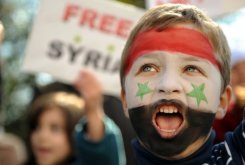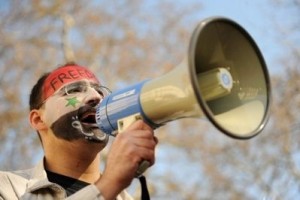 IT HAS taken a while, but this weekend Syria joined the list of Arab countries whose citizens have taken to the streets. After Friday prayers, protests were held in Damascus, the capital, as well as Banias, Homs, Deir Ezzor and Deraa in the south. The last of these was by far the best attended, with up to 2,000 people, according to eyewitnesses.
IT HAS taken a while, but this weekend Syria joined the list of Arab countries whose citizens have taken to the streets. After Friday prayers, protests were held in Damascus, the capital, as well as Banias, Homs, Deir Ezzor and Deraa in the south. The last of these was by far the best attended, with up to 2,000 people, according to eyewitnesses.
The violence has since risen. Security forces attempting to control the crowds shot and killed at least four protesters. Then on Saturday a funeral for two of them turned into another protest, which was dispersed with tear gas and fire-engine hoses. Yesterday thousands marched again, calling for an end to 48 years of emergency law, and more freedoms. One person was reportedly shot. The BBC said buildings had been torched, including the headquarters of both the ruling Baath party and the Syriatel mobile network owned by Rami Makhlouf, the business-tycoon cousin of the president, whose wealth stirs much comment and resentment. Information is hard to come by: Deraa is in semi-lockdown. Nobody is allowed in and there have been interruptions to telephone and internet services.
Syria has traditionally enjoyed a two-fold stability: it is one of the most authoritarian countries in the world and many on the streets like the president, Bashar Assad. These demonstrations mark the biggest unrest in the country since he inherited power from his father in 2000.
Small protests started on Tuesday when a group gathered in the Hamidiyeh market in Damascus. On Wednesday, a silent sit-in by known activists demanding the release of political prisoners was violently dispersed. Since then the focus of the protests has changed, with momentum now coming from outside the capital and from the general public.
 Why Deraa? It is a sleepy city of around 75,000 some 100km (62 miles) south of Damascus in a tribal Sunni area of olive groves and farmland. The spark appears to have been the arrest of more than a dozen teenagers last week for painting anti-regime graffiti on a wall. Two women were subsequently arrested. With poverty levels also rising as water levels have dropped, local anger appears to have reached a tipping point.
Why Deraa? It is a sleepy city of around 75,000 some 100km (62 miles) south of Damascus in a tribal Sunni area of olive groves and farmland. The spark appears to have been the arrest of more than a dozen teenagers last week for painting anti-regime graffiti on a wall. Two women were subsequently arrested. With poverty levels also rising as water levels have dropped, local anger appears to have reached a tipping point.
The government, previously adept at public relations, has floundered in its response. It has used force against its citizens and simultaneously accused infiltrators of dressing up as high-ranking officials and ordering forces to shoot. But it has also made concessions, reducing the duration of the loathed military service, releasing the teenagers and announcing an investigation. Faisal Kolthoum, Deraa’s governor, has been removed from his post.
There are signs the crisis in Deraa could be solved. A group of prominent locals has presented a list of demands to the government. These include the end to emergency law and the dismantling of the local security office, but not the removal of Mr Assad. Friday’s protesters had different motives in different parts of the country. In other areas, such as quiet Damascus, many disbelieve the news leaking out or prefer to turn a blind eye. Some activists want to pull back, viewing the situation as a dangerously unarticulated barrage of anger. Dormant opposition figures are complicating matters by trying to enter the fray.
But many of those who took to the streets were calling for revolution as well as protesting against corruption and abuses of power. As on Friday, small protests were reported elsewhere in the country again yesterday. Although there is no single organiser the Syria Revolution Facebook group had called for a “day of dignity” on Friday, but its influence has been limited until now. Activists have started to create information networks. More importantly perhaps, the fear that previously prevented political action has started to dissipate.
Many want change in an orderly fashion. But a continued bungled, violent response by the government could change that. Syria’s economic and political woes are similar to those lamented by protesters around the region: corruption, an exaggerated security presence, soaring prices and a lack of prospects for the country’s burgeoning, and increasingly globally connected, youth.
Leave a Reply
You must be logged in to post a comment.